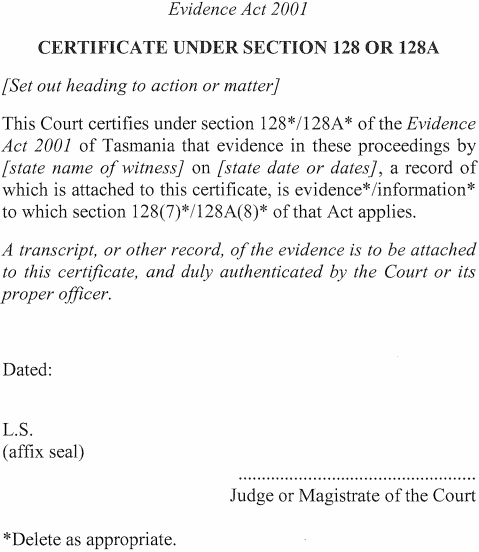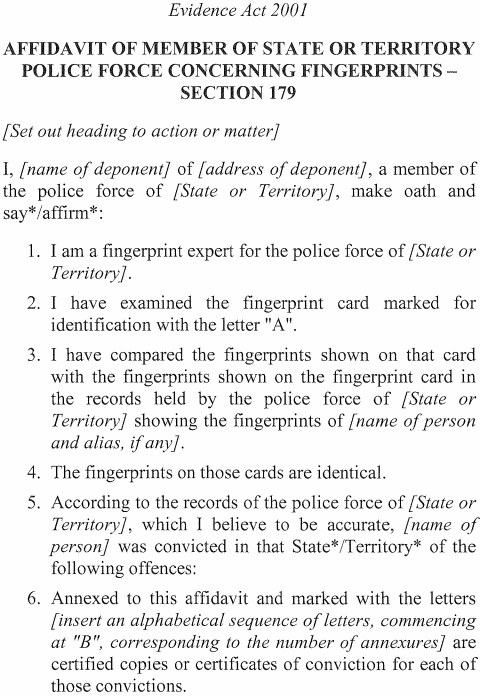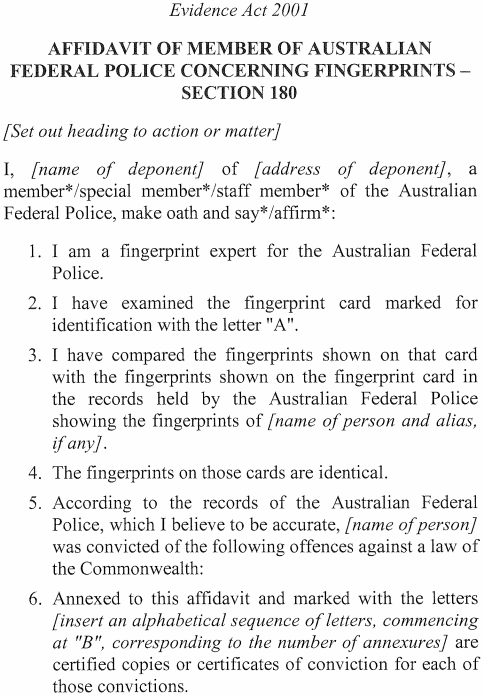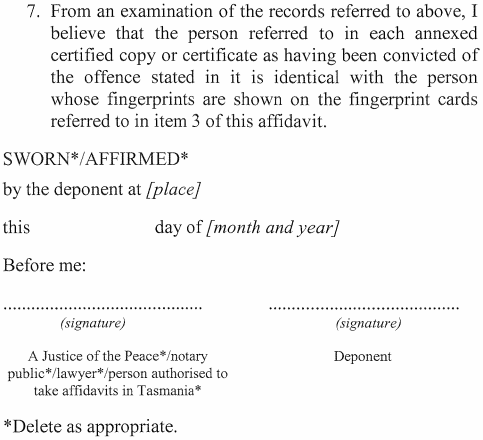Evidence Regulations 2022
I, the Governor in and over the State of Tasmania and its Dependencies in the Commonwealth of Australia, acting with the advice of the Executive Council, make the following regulations under the Evidence Act 2001 .
2 May 2022B. BAKER
Governor
By Her Excellency's Command,
ELISE ARCHER
Minister for Justice
These regulations may be cited as the Evidence Regulations 2022 .
These regulations take effect on the day on which their making is notified in the Gazette.
(1) In these regulations –Act means the Evidence Act 2001 ;address includes a private, business and official address;notifying party, in relation to a notice, means the person giving the notice.(2) In these regulations, a reference to a Form is a reference to a form set out in Schedule 1 .
4. Exceptions to hearsay rule – notices of previous representations
(1) This regulation is made for the purposes of section 67 of the Act.(2) A notice of previous representation must state –(a) subject to subregulation (6) , the substance of evidence of a previous representation that the notifying party intends to adduce; and(b) the substance of all other relevant representations made by the person who made that previous representation, so far as they are known to the notifying party; and(c) particulars of –(i) the date, time, place and circumstances at or in which each of the representations mentioned in paragraph (a) or (b) was made; and(ii) the names of the persons by whom, and the persons to whom, each of those representations was made; and(iii) in a civil proceeding, the address of each person so named, so far as they are known to the notifying party.(3) If a notifying party intends to rely on –the party’s notice of previous representation must state particulars of the facts that the party will rely on to establish that a person who made a representation referred to in the notice is not available to testify.(a) section 63(2)(a) or (b) of the Act; or(b) section 65(2)(a) , (b) , (c) or (d) of the Act; or(c) section 65(3)(a) or (b) of the Act; or(d) section 65(8)(a) or (b) of the Act –(4) If a notifying party intends to rely on section 64(2)(a) or (b) of the Act, the party’s notice of previous representation must state particulars of the facts that the party will rely on to establish the grounds specified in section 64(2) of the Act.(5) If a notice of previous representation refers to a previous representation that is in writing –(a) a copy of the document, or of the relevant portion of the document, containing the representation must be attached to the notice; and(b) the notice must identify the document unless –(i) a copy of the document is attached to the notice; and(ii) the identity of the document is apparent on the face of the copy.(6) If a copy of a document, or of a portion of a document, is attached to a notice of previous representation, it is a sufficient compliance for the purposes of subregulation (2)(a) to specify in the notice, or in the copy of a document or portion of a document attached to the notice, the representation evidence of which the notifying party intends to adduce.(7) On the application of a party in a criminal proceeding, the court may make an order directing the notifying party to disclose the address of any person named in a notice given under this regulation by whom, or to whom, a representation referred to in the notice was made.(8) The direction may be given on such terms as the court thinks fit.(9) In this regulation –notice of previous representation means a notice given under section 67(1) .
5. The tendency rule and the coincidence rule – form of notices
(1) This regulation is made for the purposes of section 99 of the Act.(2) A notice given under section 97(1)(a) of the Act (relating to the tendency rule) must state –(a) the substance of the evidence, of the kind referred to in section 97(1) of the Act, that the party giving the notice intends to adduce; and(b) if that evidence consists of, or includes, evidence of the conduct of a person, particulars of –(i) the date, time, place and circumstances at or in which the conduct occurred; and(ii) the name of each person who saw, heard or otherwise perceived the conduct; and(iii) in a civil proceeding, the address of each person so named, so far as they are known to the notifying party.(3) A notice given under section 98(1)(a) of the Act (relating to the coincidence rule) must state –(a) the substance of the evidence of the occurrence of 2 or more related events that the party giving the notice intends to adduce; and(b) particulars of –(i) the date, time, place and circumstances at or in which each of those events occurred; and(ii) the name of each person who saw, heard or otherwise perceived each of those events; and(iii) in a civil proceeding, the address of each person so named, so far as they are known to the notifying party.(4) On the application of a party in a criminal proceeding, the court may make an order directing the notifying party to disclose the address of any person named in a notice given under this regulation who saw, heard or otherwise perceived conduct or events referred to in the notice.(5) The direction may be given on such terms as the court thinks fit.
6. Privilege against self-incrimination – form of certificate
(1) A certificate under section 128 or 128A of the Act may be in accordance with Form 1.(2) A certificate is not liable to be called into question by reason of its non-compliance with Form 1.
7. Privilege against self-incrimination – prescribed State and Territory provisions
(1) The following provisions of State and Territory laws are declared to be prescribed State and Territory provisions for the purposes of section 128(12) of the Act:(a) section 128 of the Evidence Act 2011 of the Australian Capital Territory;(b) section 61 of the Coroners Act 2009 of New South Wales;(c) section 128 of the Evidence Act 1995 of New South Wales;(d) section 128 of the Evidence Act 2004 of Norfolk Island;(e) section 128 of the Evidence (National Uniform Legislation) Act 2011 of the Northern Territory;(f) section 23A of the Coroners Act 2003 of South Australia;(g) section 57 of the Coroners Act 2008 of Victoria;(h) section 128 of the Evidence Act 2008 of Victoria;(i) section 47 of the Coroners Act 1996 of Western Australia;(j) section 11 of the Evidence Act 1906 of Western Australia.(2) The following provisions of State and Territory laws are declared to be prescribed State and Territory provisions for the purposes of section 128A(11) of the Act:(a) section 128A of the Evidence Act 2011 of the Australian Capital Territory;(b) section 128A of the Evidence Act 1995 of New South Wales;(c) section 128A of the Evidence (National Uniform Legislation) Act 2011 of the Northern Territory;(d) section 128A of the Evidence Act 2008 of Victoria.
8. Fingerprint evidence of identity – affidavits by State or Territory police officers
For the purposes of section 179(1)(a) of the Act, the prescribed form of affidavit is Form 2.
9. Fingerprint evidence of identity – affidavits by Australian Federal Police officers
For the purposes of section 180(1)(a) of the Act, the prescribed form of affidavit is Form 3.
The legislation specified in Schedule 2 is rescinded.
SCHEDULE 1 - Forms
Form 1
Form 2
Form 3
SCHEDULE 2 - Legislation rescinded
Evidence Regulations 2012 (No. 26 of 2012) |
Displayed and numbered in accordance with the Rules Publication Act 1953.
Notified in the Gazette on 11 May 2022
These regulations are administered in the Department of Justice.






